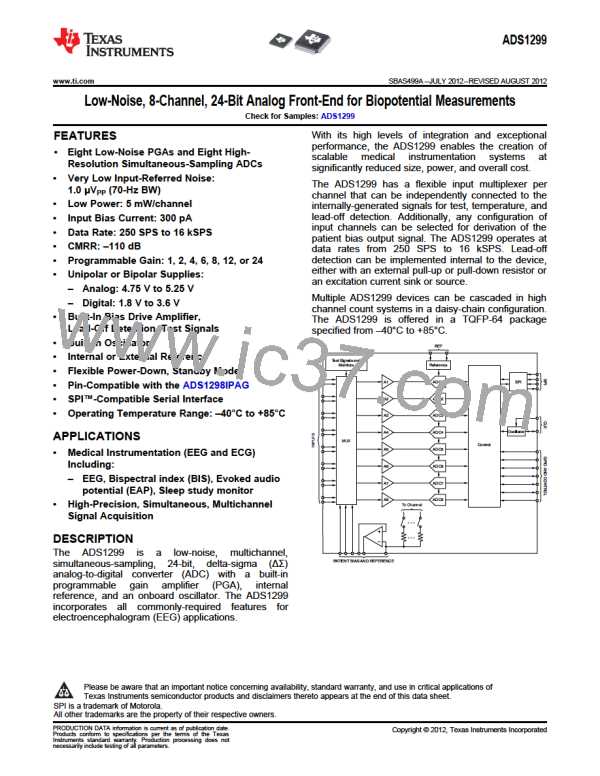ADS1299
www.ti.com
SBAS499A –JULY 2012–REVISED AUGUST 2012
SPI COMMAND DEFINITIONS
The ADS1299 provides flexible configuration control. The opcode commands, summarized in Table 10, control
and configure device operation. The opcode commands are stand-alone, except for the register read and write
operations that require a second command byte plus data. CS can be taken high or held low between opcode
commands but must stay low for the entire command operation (especially for multi-byte commands). System
opcode commands and the RDATA command are decoded by the ADS1299 on the seventh SCLK falling edge.
The register read and write opcodes are decoded on the eighth SCLK falling edge. Be sure to follow SPI timing
requirements when pulling CS high after issuing a command.
Table 10. Command Definitions
COMMAND
System Commands
WAKEUP
DESCRIPTION
FIRST BYTE
SECOND BYTE
Wake-up from standby mode
Enter standby mode
0000 0010 (02h)
0000 0100 (04h)
0000 0110 (06h)
0000 1000 (08h)
0000 1010 (0Ah)
STANDBY
RESET
Reset the device
START
Start and restart (synchronize) conversions
Stop conversion
STOP
Data Read Commands
Enable Read Data Continuous mode.
RDATAC
0001 0000 (10h)
This mode is the default mode at power-up.(1)
SDATAC
RDATA
Stop Read Data Continuously mode
0001 0001 (11h)
0001 0010 (12h)
Read data by command; supports multiple read back.
Register Read Commands
RREG
WREG
Read n nnnn registers starting at address r rrrr
Write n nnnn registers starting at address r rrrr
001r rrrr (2xh)(2)
010r rrrr (4xh)(2)
000n nnnn(2)
000n nnnn(2)
(1) When in RDATAC mode, the RREG command is ignored.
(2) n nnnn = number of registers to be read or written – 1. For example, to read or write three registers, set n nnnn = 0 (0010). r rrrr =
starting register address for read or write opcodes.
WAKEUP: Exit STANDBY Mode
This opcode exits low-power standby mode; see the STANDBY: Enter STANDBY Mode subsection of the SPI
Command Definitions section. Time is required when exiting standby mode (see the Electrical Characteristics for
details). There are no SCLK rate restrictions for this command and it can be issued at any time. Any
following commands must be sent after a delay of 4 tCLK cycles.
STANDBY: Enter STANDBY Mode
This opcode command enters low-power standby mode. All parts of the circuit are shut down except for the
reference section. The standby mode power consumption is specified in the Electrical Characteristics. There are
no SCLK rate restrictions for this command and it can be issued at any time. Do not send any other
commands other than the wakeup command after the device enters standby mode.
RESET: Reset Registers to Default Values
This command resets the digital filter cycle and returns all register settings to default values. See the Reset
(RESET) subsection of the SPI Interface section for more details. There are no SCLK rate restrictions for this
command and it can be issued at any time. 18 tCLK cycles are required to execute the RESET command.
Avoid sending any commands during this time.
START: Start Conversions
This opcode starts data conversions. Tie the START pin low to control conversions by command. If conversions
are in progress, this command has no effect. The STOP opcode command stops conversions. If the START
command is immediately followed by a STOP command, then there must be a 4-tCLK cycle delay between them.
When the START opcode is sent to the device, keep the START pin low until the STOP command is issued.
(See the START subsection of the SPI Interface section for more details.) There are no SCLK rate restrictions
for this command and it can be issued at any time.
Copyright © 2012, Texas Instruments Incorporated
Submit Documentation Feedback
35
Product Folder Link(s): ADS1299

 TI [ TEXAS INSTRUMENTS ]
TI [ TEXAS INSTRUMENTS ]